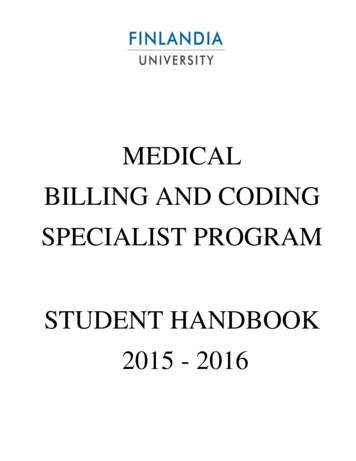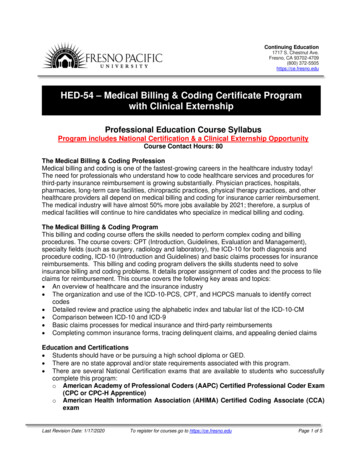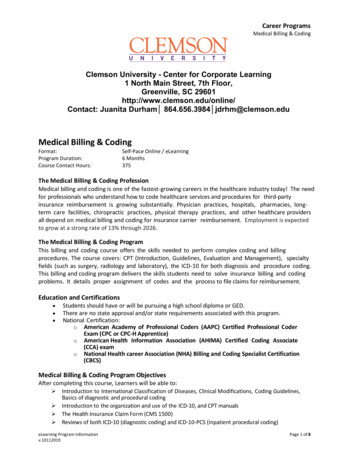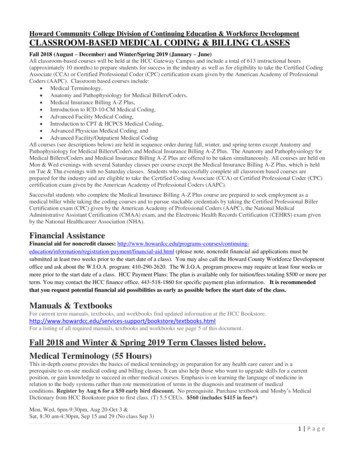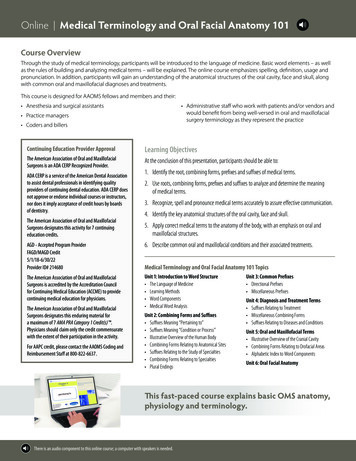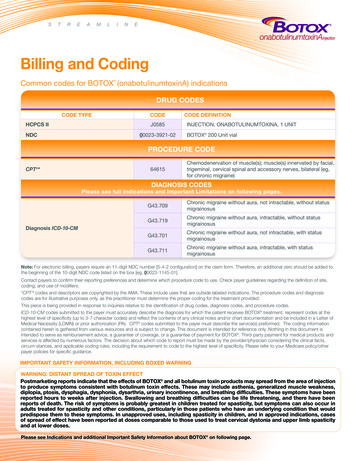
Transcription
STREAMLINEBilling and CodingCommon codes for BOTOX (onabotulinumtoxinA) indications DRUG CODESCODE TYPEHCPCS IINDCCODEJ058500023-3921-02CODE DEFINITIONINJECTION, ONABOTULINUMTOXINA, 1 UNITBOTOX 200 Unit vialPROCEDURE CODECPT *64615Chemodenervation of muscle(s); muscle(s) innervated by facial,trigeminal, cervical spinal and accessory nerves, bilateral (eg,for chronic migraine)DIAGNOSIS CODESPlease see full Indications and Important Limitations on following pages.G43.709Chronic migraine without aura, not intractable, without statusmigrainosusG43.719Chronic migraine without aura, intractable, without statusmigrainosusG43.701Chronic migraine without aura, not intractable, with statusmigrainosusG43.711Chronic migraine without aura, intractable, with statusmigrainosusDiagnosis ICD-10-CMNote: For electronic billing, payers require an 11-digit NDC number [5-4-2 configuration] on the claim form. Therefore, an additional zero should be added tothe beginning of the 10-digit NDC code listed on the box [eg, 00023-1145-01].Contact payers to confirm their reporting preferences and determine which procedure code to use. Check payer guidelines regarding the definition of site,coding, and use of modifiers.*CPT codes and descriptors are copyrighted by the AMA. These include uses that are outside labeled indications. The procedure codes and diagnosiscodes are for illustrative purposes only, as the practitioner must determine the proper coding for the treatment provided.This piece is being provided in response to inquiries relative to the identification of drug codes, diagnosis codes, and procedure codes.ICD-10-CM codes submitted to the payer must accurately describe the diagnosis for which the patient receives BOTOX treatment, represent codes at thehighest level of specificity (up to 3-7 character codes) and reflect the contents of any clinical notes and/or chart documentation and be included in a Letter ofMedical Necessity (LOMN) or prior authorization (PA). CPT codes submitted to the payer must describe the service(s) preformed. The coding informationcontained herein is gathered from various resources and is subject to change. This document is intended for reference only. Nothing in this document isintended to serve as reimbursement advice, a guarantee of coverage, or a guarantee of payment for BOTOX . Third-party payment for medical products andservices is affected by numerous factors. The decision about which code to report must be made by the provider/physician considering the clinical facts,circum-stances, and applicable coding rules, including the requirement to code to the highest level of specificity. Please refer to your Medicare policy/otherpayer policies for specific guidance.IMPORTANT SAFETY INFORMATION, INCLUDING BOXED WARNINGWARNING: DISTANT SPREAD OF TOXIN EFFECTPostmarketing reports indicate that the effects of BOTOX and all botulinum toxin products may spread from the area of injectionto produce symptoms consistent with botulinum toxin effects. These may include asthenia, generalized muscle weakness,diplopia, ptosis, dysphagia, dysphonia, dysarthria, urinary incontinence, and breathing difficulties. These symptoms have beenreported hours to weeks after injection. Swallowing and breathing difficulties can be life threatening, and there have beenreports of death. The risk of symptoms is probably greatest in children treated for spasticity, but symptoms can also occur inadults treated for spasticity and other conditions, particularly in those patients who have an underlying condition that wouldpredispose them to these symptoms. In unapproved uses, including spasticity in children, and in approved indications, casesof spread of effect have been reported at doses comparable to those used to treat cervical dystonia and upper limb spasticityand at lower doses.PleasePlease seesee IndicationsIndications andand additionaladditional ImportantImportant SafetySafety InformationInformation aboutabout BOTOXBOTOX onon followingfollowing page.page.
IndicationsChronic MigraineBOTOX (onabotulinumtoxinA) for injection is indicated for theprophylaxis of headaches in adult patients with chronic migraine ( 15 days per month with headache lasting 4 hours a day or longer).Important LimitationsSafety and effectiveness have not been established for theprophylaxis of episodic migraine (14 headache days or fewer permonth) in 7 placebo-controlled studies.IMPORTANT SAFETY INFORMATION (continued)CONTRAINDICATIONSBOTOX is contraindicated in the presence of infection atthe proposed injection site(s) and in individuals with knownhypersensitivity to any botulinum toxin preparation or to any of thecomponents in the formulation.WARNINGS AND PRECAUTIONSLack of Interchangeability Between Botulinum ToxinProductsThe potency Units of BOTOX are specific to the preparationand assay method utilized. They are not interchangeablewith other preparations of botulinum toxin products and,therefore, Units of biological activity of BOTOX cannot becompared to nor converted into Units of any other botulinumtoxin products assessed with any other specific assaymethod.Spread of Toxin EffectSee Boxed Warning.No definitive serious adverse event reports of distant spread oftoxin effect associated with BOTOX for blepharospasm at therecommended dose (30 Units and below), strabismus, or chronicmigraine at the labeled doses have been reported.Serious Adverse Reactions with Unapproved UseSerious adverse reactions, including excessive weakness,dysphagia, and aspiration pneumonia, with some adverse reactionsassociated with fatal outcomes, have been reported in patientswho received BOTOX injections for unapproved uses. In thesecases, the adverse reactions were not necessarily related to distantspread of toxin, but may have resulted from the administrationof BOTOX to the site of injection and/or adjacent structures. Inseveral of the cases, patients had pre-existing dysphagia or othersignificant disabilities. There is insufficient information to identifyfactors associated with an increased risk for adverse reactionsassociated with the unapproved uses of BOTOX . The safety andeffectiveness of BOTOX for unapproved uses have not beenestablished.Hypersensitivity ReactionsSerious and/or immediate hypersensitivity reactions have beenreported. These reactions include anaphylaxis, serum sickness,urticaria, soft-tissue edema, and dyspnea. If such a reactionoccurs, further injection of BOTOX should be discontinued andappropriate medical therapy immediately instituted. One fatal caseof anaphylaxis has been reported in which lidocaine was used asthe diluent, and consequently the causal agent cannot be reliablydetermined.Pre-Existing Neuromuscular DisordersIndividuals with peripheral motor neuropathic diseases,amyotrophic lateral sclerosis or neuromuscular junctionaldisorders (e.g., myasthenia gravis or Lambert-Eaton syndrome)should be monitored when given botulinum toxin. Patients withneuromuscular disorders may be at increased risk of clinicallysignificant effects including generalized muscle weakness,diplopia, ptosis, dysphonia, dysarthria, severe dysphagia andrespiratory compromise from therapeutic doses of BOTOX (onabotulinumtoxinA) (see Adverse Reactions).Human Albumin and Transmission of Viral DiseasesThis product contains albumin, a derivative of human blood.Based on effective donor screening and product manufacturingprocesses, it carries an extremely remote risk for transmissionof viral diseases. A theoretical risk for transmission ofCreutzfeldt-Jakob disease (CJD) is also considered extremelyremote. No cases of transmission of viral diseases or CJD haveever been reported for albumin.ADVERSE REACTIONSThe following adverse reactions to BOTOX for injection arediscussed in greater detail in the following sections: Spread ofToxin Effect (see Boxed Warning); Hypersensitivity Reactions (seeContraindications and Warnings and Precautions); Bronchitis andUpper Respiratory Tract Infections in Patients Treated for Spasticity(see Warnings and Precautions).Chronic MigraineThe most frequently reported adverse reactions following injectionof BOTOX for chronic migraine include neck pain (9%), headache(5%), eyelid ptosis (4%), migraine (4%), muscular weakness (4%),musculoskeletal stiffness (4%), bronchitis (3%), injection-site pain(3%), musculoskeletal pain (3%), myalgia (3%), facial paresis (2%),hypertension (2%), and muscle spasms (2%).Post Marketing ExperienceThere have been spontaneous reports of death, sometimesassociated with dysphagia, pneumonia, and/or other significantdebility or anaphylaxis, after treatment with botulinum toxin.There have also been reports of adverse events involving thecardiovascular system, including arrhythmia and myocardialinfarction, some with fatal outcomes. Some of these patients hadrisk factors including cardiovascular disease. The exact relationshipof these events to the botulinum toxin injection has not beenestablished.DRUG INTERACTIONSCo-administration of BOTOX and aminoglycosides or other agentsinterfering with neuromuscular transmission (eg, curare-like compounds)should only be performed with caution as the effect of the toxin may bepotentiated. Use of anticholinergic drugs after administration of BOTOX may potentiate systemic anticholinergic effects. The effect of administeringdifferent botulinum neurotoxin products at the same time or within severalmonths of each other is unknown. Excessive neuromuscular weaknessmay be exacerbated by administration of another botulinum toxin prior tothe resolution of the effects of a previously administered botulinum toxin.Excessive weakness may also be exaggerated by administration of amuscle relaxant before or after administration of BOTOX .Please see accompanying full Prescribing Information including Boxed Warning and Medication Guide. 2015 Allergan. All rights reserved. and marks owned by Allergan, Inc. CPT is a registered trademark of the American Medical Association.www.BOTOXChronicMigraine.com/HCP www.BOTOXMedical.com/HCP www.BOTOXReimbursementSolutions.com 1-800-44-BOTOX APC70RS15
HIGHLIGHTS OF PRESCRIBING INFORMATIONThese highlights do not include all the information needed to use BOTOX safelyand effectively. See full prescribing information for BOTOX.BOTOX (onabotulinumtoxinA) for injection, for intramuscular, intradetrusor,or intradermal useInitial U.S. Approval: 1989WARNING: DISTANT SPREAD OF TOXIN EFFECTSee full prescribing information for complete boxed warning.The effects of BOTOX and all botulinum toxin products may spread from the areaof injection to produce symptoms consistent with botulinum toxin effects. Thesesymptoms have been reported hours to weeks after injection. Swallowing andbreathing difficulties can be life threatening and there have been reports of death.The risk of symptoms is probably greatest in children treated for spasticity butsymptoms can also occur in adults, particularly in those patients who have anunderlying condition that would predispose them to these symptoms. (5.2)RECENT MAJOR CHANGES Indications and Usage, Upper Limb Spasticity (1.3) Dosage and Administration (2.1, 2.5) Warnings and Precautions, Serious Adverse Reactions withUnapproved Use (5.3)04/201504/201508/2015INDICATIONS AND USAGEBOTOX is an acetylcholine release inhibitor and a neuromuscular blocking agentindicated for: Treatment of overactive bladder (OAB) with symptoms of urge urinary incontinence,urgency, and frequency, in adults who have an inadequate response to or are intolerantof an anticholinergic medication (1.1) Treatment of urinary incontinence due to detrusor overactivity associated with aneurologic condition [e.g., spinal cord injury (SCI), multiple sclerosis (MS)] in adults whohave an inadequate response to or are intolerant of an anticholinergic medication (1.1) Prophylaxis of headaches in adult patients with chronic migraine ( 15 days per monthwith headache lasting 4 hours a day or longer) (1.2) Treatment of upper limb spasticity in adult patients (1.3) Treatment of cervical dystonia in adult patients, to reduce the severity of abnormal headposition and neck pain (1.4) Treatment of severe axillary hyperhidrosis that is inadequately managed by topicalagents in adult patients (1.5) Treatment of blepharospasm associated with dystonia in patients 12 years of age (1.6) Treatment of strabismus in patients 12 years of age (1.6)Important limitations: Safety and effectiveness of BOTOX have not been established for: Prophylaxis of episodic migraine (14 headache days or fewer per month). (1.2) Treatment of upper limb spasticity in pediatric patients, and for the treatment of lowerlimb spasticity in adult and pediatric patients. (1.3) Treatment of hyperhidrosis in body areas other than axillary. (1.5) DOSAGE AND ADMINISTRATION Follow indication-specific dosage and administration recommendations; Do not exceed atotal dose of 400 Units administered in a 3 month interval (2.1) See Preparation and Dilution Technique for instructions on BOTOX reconstitution, storage,and preparation before injection (2.2) Overactive Bladder: Recommended total dose 100 Units, as 0.5 mL (5 Units) injectionsacross 20 sites into the detrusor (2.3) Detrusor Overactivity associated with a Neurologic Condition: Recommended total dose200 Units, as 1 mL ( 6.7 Units) injections across 30 sites into the detrusor (2.3) Chronic Migraine: Recommended total dose 155 Units, as 0.1 mL (5 Units) injections pereach site divided across 7 head/neck muscles (2.4) Upper Limb Spasticity: Select dose based on muscles affected, severity of muscleactivity, prior response to treatment, and adverse event history; Electromyographicguidance recommended (2.5) Cervical Dystonia: Base dosing on the patient’s head and neck position, localization ofpain, muscle hypertrophy, patient response, and adverse event history; use lower initialdose in botulinum toxin naïve patients (2.6)FULL PRESCRIBING INFORMATION: CONTENTS*WARNING: DISTANT SPREAD OF TOXIN EFFECT1 INDICATIONS AND USAGE1.1 Bladder Dysfunction1.2 Chronic Migraine1.3 Upper Limb Spasticity1.4 Cervical Dystonia1.5 Primary Axillary Hyperhidrosis1.6 Blepharospasm and Strabismus A xillary Hyperhidrosis: 50 Units per axilla (2.7) Blepharospasm: 1.25 Units-2.5 Units into each of 3 sites per affected eye (2.8) Strabismus: 1.25 Units-2.5 Units initially in any one muscle (2.9)DOSAGE FORMS AND STRENGTHSSingle-use, sterile 100 Units or 200 Units vacuum-dried powder for reconstitution only withsterile, preservative-free 0.9% Sodium Chloride Injection USP prior to injection (3)CONTRAINDICATIONS H ypersensitivity to any botulinum toxin preparation or to any of the components in theformulation (4.1, 5.4, 6) Infection at the proposed injection site (4.2) Intradetrusor Injections: Urinary Tract Infection or Urinary Retention (4.3)WARNINGS AND PRECAUTIONS P otency Units of BOTOX are not interchangeable with other preparations of botulinumtoxin products (5.1, 11) Spread of toxin effects; swallowing and breathing difficulties can lead to death. Seekimmediate medical attention if respiratory, speech or swallowing difficulties occur(5.2, 5.6) Potential serious adverse reactions after BOTOX injections for unapproved uses (5.3) Concomitant neuromuscular disorder may exacerbate clinical effects of treatment (5.5) Use with caution in patients with compromised respiratory function (5.6, 5.7, 5.10) Corneal exposure and ulceration due to reduced blinking may occur with BOTOXtreatment of blepharospasm (5.8) Retrobulbar hemorrhages and compromised retinal circulation may occur with BOTOXtreatment of strabismus (5.9) Bronchitis and upper respiratory tract infections in patients treated for upper limbspasticity (5.10) Urinary tract infections in patients treated for OAB (5.12) Urinary retention: Post-void residual urine volume should be monitored in patientstreated for OAB or detrusor overactivity associated with a neurologic condition whodo not catheterize routinely, particularly patients with multiple sclerosis or diabetesmellitus. (5.13)ADVERSE REACTIONSThe most common adverse reactions ( 5% and placebo) are (6.1): OAB: urinary tract infection, dysuria, urinary retention Detrusor Overactivity associated with a neurologic condition: urinary tract infection,urinary retention Chronic Migraine: neck pain, headache Spasticity: pain in extremity Cervical Dystonia: dysphagia, upper respiratory infection, neck pain, headache, increasedcough, flu syndrome, back pain, rhinitis Axillary Hyperhidrosis: injection site pain and hemorrhage, non-axillary sweating,pharyngitis, flu syndromeTo report SUSPECTED ADVERSE REACTIONS, contact Allergan at1-800-433-8871 or FDA at 1-800-FDA-1088 or www.fda.gov/medwatch.DRUG INTERACTIONSPatients receiving concomitant treatment of BOTOX and aminoglycosides or other agentsinterfering with neuromuscular transmission (e.g., curare-like agents), or muscle relaxants,should be observed closely because the effect of BOTOX may be potentiated (7)USE IN SPECIFIC POPULATIONS P regnancy: Based on animal data, may cause fetal harm (8.1) Pediatric Use: Safety and efficacy are not established in patients under 18 years ofage for the prophylaxis of headaches in chronic migraine, treatment of OAB, detrusoroveractivity associated with a neurologic condition, upper limb spasticity, and axillaryhyperhidrosis; in patients under 16 years of age for treatment of cervical dystonia; and inpatients under 12 years of age for treatment of blepharospasm and strabismus (8.4)See 17 for PATIENT COUNSELING INFORMATION and Medication Guide.Revised: 08/20152 DOSAGE AND ADMINISTRATION2.1 Instructions for Safe Use2.2 Preparation and Dilution Technique2.3 Bladder Dysfunction2.4 Chronic Migraine2.5 Upper Limb Spasticity2.6 Cervical Dystonia2.7 Primary Axillary Hyperhidrosis2.8 Blepharospasm2.9 Strabismus
3 DOSAGE FORMS AND STRENGTHS4 CONTRAINDICATIONS4.1 Known Hypersensitivity to Botulinum Toxin4.2 Infection at the Injection Site(s)4.3 Urinary Tract Infection or Urinary Retention5 WARNINGS AND PRECAUTIONS5.1 Lack of Interchangeability between Botulinum Toxin Products5.2 Spread of Toxin Effect5.3 Serious Adverse Reactions with Unapproved Use5.4 Hypersensitivity Reactions5.5 Pre-Existing Neuromuscular Disorders5.6 Dysphagia and Breathing Difficulties5.7 Pulmonary Effects of BOTOX in Patients with Compromised RespiratoryStatus Treated for Spasticity or for Detrusor Overactivity associated witha Neurologic Condition5.8 Corneal Exposure and Ulceration in Patients Treated with BOTOX forBlepharospasm5.9 Retrobulbar Hemorrhages in Patients Treated with BOTOX for Strabismus5.10 Bronchitis and Upper Respiratory Tract Infections in Patients Treated for Spasticity5.11 Autonomic Dysreflexia in Patients Treated for Detrusor Overactivity associated witha Neurologic Condition5.12 Urinary Tract Infections in Patients with Overactive Bladder5.13 Urinary Retention in Patients Treated for Bladder Dysfunction5.14 Human Albumin and Transmission of Viral Diseases6 ADVERSE REACTIONS6.1 Clinical Trials Experience6.2 Immunogenicity6.3 Post-Marketing Experience7 DRUG INTERACTIONS7.1 Aminoglycosides and Other Agents Interfering with Neuromuscular Transmission7.2 Anticholinergic Drugs7.3 Other Botulinum Neurotoxin Products7.4 Muscle Relaxants8 USE IN SPECIFIC POPULATIONS8.1 Pregnancy8.3 Nursing Mothers8.4 Pediatric Use8.5 Geriatric Use10 OVERDOSAGE11 DESCRIPTION12 CLINICAL PHARMACOLOGY12.1 Mechanism of Action12.3 Pharmacokinetics13 NONCLINICAL TOXICOLOGY13.1 Carcinogenesis, Mutagenesis, Impairment of Fertility13.2 Animal Toxicology14 CLINICAL STUDIES14.1 Overactive Bladder (OAB)14.2 Detrusor Overactivity associated with a Neurologic Condition14.3 Chronic Migraine14.4 Upper Limb Spasticity14.5 Cervical Dystonia14.6 Primary Axillary Hyperhidrosis14.7 Blepharospasm14.8 Strabismus16 HOW SUPPLIED/STORAGE AND HANDLING17 PATIENT COUNSELING INFORMATION* Sections or subsections omitted from the full prescribing information are not listed.FULL PRESCRIBING INFORMATIONWARNING: DISTANT SPREAD OF TOXIN EFFECTPostmarketing reports indicate that the effects of BOTOX and all botulinum toxinproducts may spread from the area of injection to produce symptoms consistentwith botulinum toxin effects. These may include asthenia, generalized muscleweakness, diplopia, ptosis, dysphagia, dysphonia, dysarthria, urinary incontinenceand breathing difficulties. These symptoms have been reported hours to weeksafter injection. Swallowing and breathing difficulties can be life threatening andthere have been reports of death. The risk of symptoms is probably greatest inchildren treated for spasticity but symptoms can also occur in adults treatedfor spasticity and other conditions, particularly in those patients who havean underlying condition that would predispose them to these symptoms. Inunapproved uses, including spasticity in children, and in approved indications,cases of spread of effect have been reported at doses comparable to those usedto treat cervical dystonia and upper limb spasticity and at lower doses. [SeeWarnings and Precautions (5.2)]1INDICATIONS AND USAGE1.1 Bladder DysfunctionOveractive BladderBOTOX (onabotulinumtoxinA) for injection is indicated for the treatment of overactivebladder with symptoms of urge urinary incontinence, urgency, and frequency, in adults whohave an inadequate response to or are intolerant of an anticholinergic medication.Detrusor Overactivity associated with a Neurologic ConditionBOTOX is indicated for the treatment of urinary incontinence due to detrusor overactivityassociated with a neurologic condition (e.g., SCI, MS) in adults who have an inadequateresponse to or are intolerant of an anticholinergic medication.1.2 Chronic MigraineBOTOX is indicated for the prophylaxis of headaches in adult patients with chronic migraine( 15 days per month with headache lasting 4 hours a day or longer).Important limitationsSafety and effectiveness have not been established for the prophylaxis of episodic migraine(14 headache days or fewer per month) in seven placebo-controlled studies.1.3 Upper Limb SpasticityBOTOX is indicated for the treatment of upper limb spasticity in adult patients, to decreasethe severity of increased muscle tone in elbow flexors (biceps), wrist flexors (flexor carpiradialis and flexor carpi ulnaris), finger flexors (flexor digitorum profundus and flexordigitorum sublimis), and thumb flexors (adductor pollicis and flexor pollicis longus).Important limitationsSafety and effectiveness of BOTOX have not been established for the treatment of otherupper limb muscle groups, or for the treatment of lower limb spasticity. Safety andeffectiveness of BOTOX have not been established for the treatment of spasticity in pediatricpatients under age 18 years. BOTOX has not been shown to improve upper extremityfunctional abilities, or range of motion at a joint affected by a fixed contracture. Treatmentwith BOTOX is not intended to substitute for usual standard of care rehabilitation regimens.1.4 Cervical DystoniaBOTOX is indicated for the treatment of adults with cervical dystonia, to reduce the severityof abnormal head position and neck pain associated with cervical dystonia.1.5 Primary Axillary HyperhidrosisBOTOX is indicated for the treatment of severe primary axillary hyperhidrosis that isinadequately managed with topical agents.Important limitationsThe safety and effectiveness of BOTOX for hyperhidrosis in other body areas have not beenestablished. Weakness of hand muscles and blepharoptosis may occur in patients whoreceive BOTOX for palmar hyperhidrosis and facial hyperhidrosis, respectively. Patientsshould be evaluated for potential causes of secondary hyperhidrosis (e.g., hyperthyroidism)to avoid symptomatic treatment of hyperhidrosis without the diagnosis and/or treatment ofthe underlying disease.Safety and effectiveness of BOTOX have not been established for the treatment of axillaryhyperhidrosis in pediatric patients under age 18.1.6 Blepharospasm and StrabismusBOTOX is indicated for the treatment of strabismus and blepharospasm associated withdystonia, including benign essential blepharospasm or VII nerve disorders in patients 12years of age and above.2DOSAGE AND ADMINISTRATION2.1 Instructions for Safe UseThe potency Units of BOTOX (onabotulinumtoxinA) for injection are specific to thepreparation and assay method utilized. They are not interchangeable with otherpreparations of botulinum toxin products and, therefore, units of biological activity ofBOTOX cannot be compared to nor converted into units of any other botulinum toxinproducts assessed with any other specific assay method [see Warnings and Precautions(5.1) and Description (11)].Indication specific dosage and administration recommendations should be followed.When initiating treatment, the lowest recommended dose should be used. In treating adultpatients for one or more indications, the maximum cumulative dose should not exceed400 Units, in a 3 month interval.The safe and effective use of BOTOX depends upon proper storage of the product,selection of the correct dose, and proper reconstitution and administration techniques. Anunderstanding of standard electromyographic techniques is also required for treatment ofstrabismus and of upper limb spasticity, and may be useful for the treatment of cervicaldystonia. Physicians administering BOTOX must understand the relevant neuromuscularand structural anatomy of the area involved and any alterations to the anatomy due to priorsurgical procedures and disease, especially when injecting near the lungs.2.2 Preparation and Dilution TechniquePrior to injection, reconstitute each vacuum-dried vial of BOTOX with only sterile,preservative-free 0.9% Sodium Chloride Injection USP. Draw up the proper amount ofdiluent in the appropriate size syringe (see Table 1, or for specific instructions for detrusoroveractivity associated with a neurologic condition see Section 2.3), and slowly injectthe diluent into the vial. Discard the vial if a vacuum does not pull the diluent into thevial. Gently mix BOTOX with the saline by rotating the vial. Record the date and time ofreconstitution on the space on the label. BOTOX should be administered within 24 hoursafter reconstitution. During this time period, reconstituted BOTOX should be stored in arefrigerator (2 to 8 C).
Table 1: Dilution Instructions for BOTOX Vials (100 Units and 200 Units)**Diluent* Added to100 Unit VialResulting DoseUnits per 0.1 mLDiluent* Added to200 Unit VialResulting DoseUnits per 0.1 mL1 mL2 mL4 mL8 mL10 mL10 Units5 Units2.5 Units1.25 Units1 Unit1 mL2 mL4 mL8 mL10 mL20 Units10 Units5 Units2.5 Units2 Units* Preservative-free 0.9% Sodium Chloride Injection, USP Only** For Detrusor Overactivity associated with a Neurologic Condition Dilution see Section 2.3Note: These dilutions are calculated for an injection volume of 0.1 mL. A decrease orincrease in the BOTOX dose is also possible by administering a smaller or larger injectionvolume - from 0.05 mL (50% decrease in dose) to 0.15 mL (50% increase in dose).An injection of BOTOX is prepared by drawing into an appropriately sized sterile syringean amount of the properly reconstituted toxin slightly greater than the intended dose. Airbubbles in the syringe barrel are expelled and the syringe is attached to an appropriateinjection needle. Patency of the needle should be confirmed. A new, sterile needle andsyringe should be used to enter the vial on each occasion for removal of BOTOX.Reconstituted BOTOX should be clear, colorless, and free of particulate matter. Parenteraldrug products should be inspected visually for particulate matter and discoloration prior toadministration and whenever the solution and the container permit.2.3 Bladder DysfunctionGeneralPatients must not have a urinary tract infection (UTI) at the time of treatment. Prophylacticantibiotics, except aminoglycosides, [see Drug Interactions (7.1)] should be administered1-3 days pre-treatment, on the treatment day, and 1-3 days post-treatment to reduce thelikelihood of procedure-related UTI.Patients should discontinue anti-platelet therapy at least 3 days before the injectionprocedure. Patients on anti-coagulant therapy need to be managed appropriately todecrease the risk of bleeding.Appropriate caution should be exercised when performing a cystoscopy.Overactive BladderAn intravesical instillation of diluted local anesthetic with or without sedation may be usedprior to injection, per local site practice. If a local anesthetic instillation is performed, thebladder should be drained and irrigated with sterile saline before injection.The recommended dose is 100 Units of BOTOX, and is the maximum recommended dose.The recommended dilution is 100 Units/10 mL with preservative-free 0.9% Sodium ChlorideInjection, USP (see Table 1). Dispose of any unused saline.Reconstituted BOTOX (100 Units/10 mL) is injected into the detrusor muscle via a flexible orrigid cystoscope, avoiding the trigone. The bladder should be instilled with enough saline toachieve adequate visualization for the injections, but over-distension should be avoided.The injection needle should be filled (primed) with approximately 1 mL of reconstitutedBOTOX prior to the start of injections (depending on the needle length) to remove any air.The needle should be inserted approximately 2 mm into the detrusor, and 20 injectionsof 0.5 mL each (total volume of 10 mL) should be spaced approximately 1 cm apart (seeFigure 1). For the final injection, approximately 1 mL of sterile normal saline should beinjected so that the remaining BOTOX in the needle is delivered to the bladder. After theinjections are given, patients should demonstrate their ability to void prior to leaving theclinic. The patient should be observed for at least 30 minutes post-injection and until aspontaneous void has occurred.Patients should be considered for reinjection when the clinical e
Billing and Coding. Note: For electronic billing, payers require an 11-digit NDC number [5-4-2 configuration] on the claim form. Therefore, an additional zero should be added to the beginning of the 10-digit NDC code listed on the box [eg, 0. 0023-1145-01]. Contact payers to confirm their reporting preferences and determine which procedure code .

